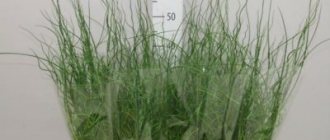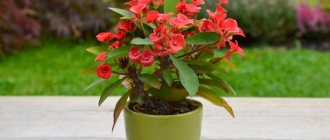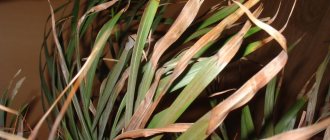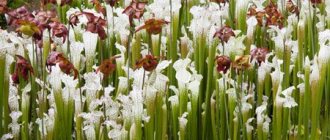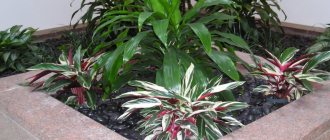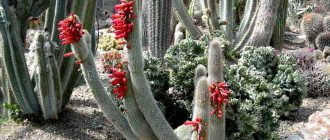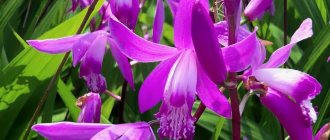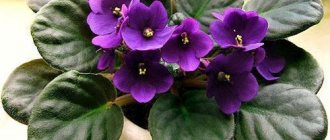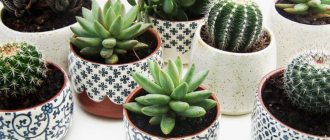Distinctive features of the palm tree
Some types of indoor palm trees can grow in partial shade, allowing you to create interesting corners in the room, the center of which is an exotic plant.
With the help of such crops, loggias and verandas are often landscaped. Even in a place with harsh winters, they are an integral part of the garden in summer, where plants are usually taken out directly in tubs. In total, there are about 2,800 species of palm trees on the planet . Their main difference from most plants is that the leaves are located at the top. But there are also species in which the leaf blades start from the root bud itself. Based on the characteristics of the trunk and leaves, there are the following divisions of indoor palm trees, which are called as follows:
- Reed. These species include Rapus and Hamedorea. The stems of these plants are tall, thin, reed-like. By the way, these crops are blooming.
- Cirrus (pinnate). The most popular pinnates are: Hamedorea eleganta, Howea Belmora and Forestera, Robelen date palm, Canary date, Gomuti, Raffia. These crops are distinguished by the presence of narrow leaves that are curved in an arch. They can grow upward or be straight. In addition to this group, palm trees are both hard and soft.
- Fan. This includes Hamerops tall and squat, Rapis tall, Washingtonia, Livistonia chinensis (Asian). The trunk splits into several segments that extend from the center, looking like a round fan. They grow very large, and the cuttings have thorns.
- Sagoceae. False palms, but at the same time they look like real ones. Only one species is grown for decorative purposes - Cycad avertus. This plant is a low palm tree that has a cone-shaped small trunk, from which long feathery leaves emanate.
- Fish tail. Kariota can be classified as this species. The leaves resemble a fish tail: the fins are triangular or diamond-shaped, which is where the name comes from. These palms are considered one of the fastest growing. Externally, the leaves resemble torn corn leaves.
Quite often, inexperienced gardeners mistake plants that resemble them in appearance for palm trees. For example, bat palms, yuccas or dracaenas.
Palm-like plants
The group of palm-like plants includes species that only vaguely resemble in appearance representatives of the Arecaceae family. Often these are herbaceous plants or succulents; there is a shrub with fruits that taste identical to dates, but they are classified as palm trees only by popular imagination.
Hawaiian palm Brighamia is a perennial succulent from the Campanaceae family, endemic to the Hawaiian archipelago. A short-lived plant that is on the verge of extinction - only a few specimens remain in nature under protection in Na Pali Coast National Park, located on the island of Kauai.
The plant has a thick, unbranched stem, reaching a height of 1–2 m, less often 5 m. At its crown there is a rosette of fleshy, spoon-shaped leaves. It blooms in autumn with fragrant funnel-shaped flowers of lemon or cream color, forming an inflorescence of 3-8 pieces.
Hawaiian Palm Brighamia
Panama palm Carludovica (Carludovica) is a low palm-shaped plant from the Cyclantaceae family - only 4 species in the genus, common in the tropical latitudes of America. Named after the Spanish monarch Charles IV. Leaves on long petioles are beautifully fan-shaped, three or five dissected. The flowers resemble balls on a cylindrical cob, the fruits are tetrahedral berries.
Panamanian palm Karludovic
Banana palm Banana (Musa) is a herbaceous plant of the Banana family, in nature it grows up to 7 m. It is widespread in Southeast Asia, but mostly on the islands of the Malay Archipelago. The genus includes up to 70 species of large herbs, which are often mistaken for trees, with a powerful root system and a very short trunk that practically does not protrude above the soil surface. What many people mistake for a trunk are actually tightly fitting leaf sheaths - large, oval, soft.
When the plant is about to bloom, a long peduncle is formed inside this false stem, raising upward a brush with male and female flowers of purple or greenish color.
Banana Palm Banana
The castor palm (Ricinus) is the only herbaceous plant in the genus, the castor plant, which belongs to the Euphorbiaceae family. In temperate latitudes it is considered a medicinal, oilseed and gardening annual crop; in tropical regions it grows as an evergreen shrub. Supposedly originates from Ethiopia, but has spread throughout the world. In some countries it has been grown for more than 4 thousand years.
The stems are hollow, growing vertically, and have different shades - purple, reddish-burgundy, pink or almost black. The leaves are huge, sometimes reaching 80 cm in diameter, with a beautiful maple-like shape on long petioles. The flowers in the axillary inflorescences are small and inconspicuous, but the spiny fruit capsules with oval seeds inside look quite exotic.
Castor palm
Snake palm Amorphophallus is a tuberous plant from the Araceae family. The genus consists of 170 species found in West Africa and the Pacific Islands. One of the species has the largest inflorescence in the plant world, 2.5 m high, with the most unpleasant smell of rotten fish and spoiled eggs.
It grows from an underground turnip-shaped tuber, throwing out only one tripartite leaf, very rarely - 2-3. The inflorescence is an elongated spadix, wrapped in a blanket, white-green on the outside, crimson or purple on the inside.
Snake Palm Amorphophallus
Unabi Chinese date, or real jujube (Ziziphus jujuba) - the species belongs to the genus Jujube of the Buckthorn family. A small tree or shrub with thick bark and simple oval leaves. It blooms with inconspicuous miniature light green-white flowers. The fruits are very tasty and juicy drupes with sweet reddish-brown pulp, reminiscent of dates in taste.
Unabi Chinese date
Cycas sago palm (Cycas) is a cycad from the genus of the same name, which is the only one in the Cycas family, consisting of 90 species. It lives in Asia, Indonesia, the Pacific Islands, as well as Australia and Madagascar. It is very similar to a palm tree, grows up to 15 m in height, the trunk is thick in circumference even with a relatively short stature. The feathery leaves are concentrated at the crown of the trunk in the form of a tuft.
Sago Palm Cycas
Bottle palm Nolina, or Beacarnea, is a tropical plant from the Asparagus family, native to southern Mexico. The barrel of the nolina is shaped like a bottle. The thickening in its lower part serves to accumulate moisture and nutrients. At the top a tuft of narrow linear leaves is formed. Due to its exotic appearance, it is popular in decorative floriculture and is popularly called “horse tail” or “elephant foot”.
Bottle palm Nolina, or Bocarnea
Madagascar palm Pachypodium lamerei is a species from the Pachypodium genus of the Kutrovaceae family. The plant has a tall, thick silver-gray trunk with characteristic thorns, which occasionally branches. The leaves are narrow, with a distinct central vein, forming a rosette at the top.
In the natural environment it grows up to 6 m, but in indoor conditions it grows slowly and does not reach more than 1.8 m. It blooms reluctantly indoors, but in the garden it produces spectacular large snow-white flowers with a pleasant aroma.
Madagascar palm Pachypodium lamera
Euphorbia palm, or White-veined Euphorbia (Euphorbia leuconeura) is a plant with a thickened 4- or 5-rib trunk and a beautiful rosette of elongated oval leaves from 10 to 20 cm long with light veins. The flowers are small, thread-like and very rich in nectar. The three-nest fruit capsule has the unpleasant property of shooting seeds all over the room. Once in neighboring pots, they germinate beautifully.
Euphorbia palm, or Euphorbia palm
Cat palm Cyperus is a swamp tropical representative of the sedge family with straight herbaceous stems topped with an umbrella-tuft of hard linear leaves. There are about 700 species in the genus Syt, but several are popular indoors, especially loved by domestic cats, which is why they received such a popular name.
Cat palm Cyperus
False palms
There are several indoor plants that look similar to palm trees, but they are different species. It is more profitable to plant them, since the flowers grow slowly and, as adults, fit in apartments. These are mainly hybrid adapted varieties of indoor palm trees, which are much easier to care for in a pot at home.
In nature, palm-like flowers grow very large, but at home they are much smaller.
A variety of domestic palm is the Yucca plant with a thick trunk and a bunch of wide leaves growing in a spiral. If the yucca likes its growing conditions, the lower leaves do not die off, and it turns into a spreading tree.
You can choose yucca of any color - green, with white veins, purple. Those trees that have several branches are expensive in stores, since it takes a long time for side shoots to grow.
Varieties of fan palms
There are many varieties of fan palms, and they all have one main feature in common: the unusual shape of the leaves . Each sheet is a plate, dissected in the form of rays into many parts. Among the most popular are five species that are preferred for growing in apartments.
- Liviston . This plant loves moist air, frequent watering with warm water and does not tolerate drought. At home, it can grow up to two meters, bears two or three new stems with leaves per year, and reaches maturity at the age of five.
- Washingtonia . An unpretentious plant, loves bright places and fresh air. It tolerates lack of humidity well, but for its best development it requires regular spraying. It is sensitive to transplantation, so it is better not to abuse it.
- Trachycarpus . A cold-resistant variety that prefers abundant watering and outdoor recreation. Propagated by seeds and grows well in well-drained soil. Transplantation is carried out after the pot is completely filled with the roots of the plant.
Tropical beauties
Indoor palms come from the tropics. There are about 3 thousand species in the world, but only a few take root in apartment conditions.
According to the structure of palm trees there are:
- fan;
- reed;
- feathery;
- sago;
- "fish tail".
These indoor trees need special conditions where there is enough moisture, heat, and light. They require constant spraying: three times a week in summer, daily in winter. The dry air in apartments is harmful to them. Timely watering of plants is important, but not excessive, good drainage is required.
The decorative palm tree does not tolerate direct sunlight, loves diffused lighting, does not tolerate cold window sills, and is easily destroyed there. Tropical plants do not like drafts or hypothermia. They need to create a stable microclimate and maintain it constantly.
At home, in a tub, the date palm reaches a height of two meters. An adult specimen blooms with small yellow flowers. One cannot expect the fruits that many people love to appear from it. They grow only in natural conditions, where the height of the tree reaches three tens of meters.
Transfer
Indoor palm trees do not like to be transplanted; they should not be disturbed again. One of the reasons for carrying out the procedure is the growth of the root system, filling the entire earthen lump in a pot or flowerpot.
Young plants are replanted in the first 3 years - once a year, adult specimens less often - once every 3-4 years. If the plant is very large and replanting it is problematic, then the top layer of soil in the container is changed.
Transplantation is best done in the spring . The new container for a grown palm tree should be 3–5 cm larger than the previous one. It is imperative to take care of drainage; there should be no stagnation of water at the roots. A layer of expanded clay is placed at the bottom of the pot.
The main thing when replanting is not to damage the leaves and petioles . The plant is carefully transferred to a new container. You also need to pay attention to the roots . In mature palm trees, they often rot, so when replanting, the dead parts are carefully removed. If the damage is severe, then immediately after the procedure you need to provide lower heating to 25–30°C. This way rooting will go faster and there will be a greater chance that the plant will survive. At first, the transplanted palm tree is protected from direct sunlight.
Not suitable for growing indoors
For many reasons, most palms remain unknown in indoor floriculture. Most often this happens due to its gigantic size or growth characteristics. These include:
- An oilseed that grows in Africa. The tree reaches a height of 30 m. Once every 2 years, the palm tree sheds its leaves.
- Serenou creeping. This type of palm grows in the southern United States, as well as on the islands of the Caribbean. The plant grows very slowly, reaching a height of no more than 4 meters. The flowers emit a pleasant smell.
- Wax or Carnauba. Under natural conditions, the plant can be found in South America. The palm has discolored leaves that form a lush scarf. Science knows several species of this plant.
- Bismarck. The plant can be found in Madagascar. Silver leaves.
- Pandanus or screw palm. The leaves on the tree trunk are arranged in several rows, in a spiral.
- Rattan or Calamus palm. This plant is the longest in the world; its leaves grow from buds on the trunk. Plants easily cling to trees with the help of thorns located at the ends of the leaves .
Popular types of indoor palm trees
The palm houseplant is native to the regions of America and Africa. They are often found in Madagascar, Colombia, Spain, Southern France and Greece. Dates are common on the island of Crete. They grow in nature even in the countries of the former CIS: Russia, the Caucasus, Uzbekistan, Georgia, Azerbaijan. Tropical crops are successfully grown in botanical gardens.
Home palm has different names, they differ in varieties. You can buy them in specialized stores. The price depends on the prevalence of the culture; some varieties can only be found in home collections. It is worth considering the varieties common in indoor floriculture.
Brachea
This is a monocotyledonous plant. Its homeland is considered to be Central and North America. In nature it grows in dry mountain areas, and is now successfully grown as an ornamental foliage.
Main parameters:
- Height. In nature - more than 12 m; when grown in an apartment, it depends on the size of the pot.
- Trunk. It becomes bare as Brachea grows due to the drying of old leaf blades. It has a gray-brown color, it is thick, reaching 50 cm in diameter in an adult Brachea.
- The leaves are in the form of a dissected fan, including hard segments with pointed tips. Leaf color is pale green.
- Flowering occurs only in nature. In appearance, the flowers resemble glasses and consist of three sepals.
- The root is powerful and goes deep, so when growing an adult Brachea indoors, you need a deep tub.
Brachea can be considered one of the most unpretentious palms. She reacts normally to lack of light.
Caryota
Having seen the forked feathery leaves of this palm tree, it is no longer possible to forget their unique appearance. Thanks to this shape of foliage, the indoor palm tree in the photo is called “fishtail”.
The native Asian species loves the sun; when grown indoors, if the plant is fed regularly, it does not notice a lack of soil. But dry air leads to a decrease in the intensity of foliage color and to attacks on plants by pests.
Most often, mitis or mild caryota takes root at home. This plant forms several stems, the tops of which are decorated with lush plumes of leaves.
But sometimes in flower shops you can see another variety of home palm. Caryota urens or stinging grows in a single stem. In young specimens, growth is slow, but when reaching a height of 1.5–2 meters, palm trees catch up and grow quickly.
Indoor palm tree Howey
Palm Howea (Kentia) is one of the subspecies of pinnate palms. It is endemic to Lord Howe and not found elsewhere. There are three popular types of this palm:
- Forster;
- Large-fruited;
- Belmora.
The height in the natural environment reaches 15 meters, and the length of the foliage is up to 5. Khovea has a wide, spreading crown. The surface of the trunk consists of ring-shaped formations in the form of scars from dead leaves. Caring for the plant is not difficult. All you need to do is control soil moisture. This palm tree is often used to decorate gardens, offices, and business centers.
Indoor palm tree Howey (click on photo to enlarge).
Indoor palm tree Howey (click on photo to enlarge).
Howea does not require special care: it can remain for a long time without moisture and out of light. However, experts advise to ventilate the premises well and not to smoke near it. The usual temperature at which wild Hovei grow is within +20...+25 °C. The minimum temperature it can withstand is +10 °C.
Indoor palm Gioforba
Giophorba palm , also called the bottle palm, grows in the island regions of the Indian Ocean. Under natural conditions, the height does not exceed seven meters. Gyophorba has a seal in the middle of the trunk. It itself is smooth, without scars or other formations. The feathery elements give the palm fan a presentable appearance. Gioforba requires careful care. The room temperature should not fall below +16 °C. It is not recommended to place it near windows on the south side.
Indoor palm tree Gioforba (click on photo to enlarge).
Indoor palm tree Gioforba (click on photo to enlarge).
Hyophorbe needs to be watered on time, and the leaves need to be wiped off dust (but not during wintering). This palm tree grows slowly and if it gets sick, the recovery process will also be long. Dried foliage will indicate deterioration of the condition. To prevent this from happening, you need to monitor the humidity in the room. You can place a container of water or an aquarium next to the hyophorba.
How to water a palm tree correctly and with what water
Try not to water your plant with hard water (from the tap), but choose soft and purified water (can be rain) for watering. If you ignore this recommendation, the soil mixture in which the palm tree will grow will become saturated with salts, and this will negatively affect the “nutrition” of the plant, it will become weak, and the leaves will begin to turn yellow.
As for the temperature of the water for irrigation, in no case should it be lower than the effective temperature in the room where the palm tree grows, remember this, otherwise your tropical guest will begin to get sick. Watering the palm tree itself can be roughly divided into 3 types: without drying the earthen lump, with slight drying of the earthen extract, and with strong drying of the contents of the flower pot. The last option of watering should not be too frequent, as the roots of the plant may begin to rot.
How much water to water a palm tree? Fortunately, you are dealing with a “smart” plant, therefore, it has the ability to regulate the processes of water consumption, so you just need to maintain regular watering, and your palm tree will sort out the rest on its own. It will release excess moisture through a drainage hole in the pot (it must be there). But it will get the lack of moisture, although not from the amount of water for irrigation, but from the frequency and regularity of irrigation.
Palma Washingtonia
The distribution area in nature is the dry areas of the Southwestern United States. The two most famous types of this plant are robusta and filifera. The second subspecies is also called thread palm. It received this name because of the “beard” that forms in adult individuals from fallen leaves. In the natural environment, these threads envelop the tree, completely hiding the trunk. The first subspecies is more common in Mexico and is smaller in size than the American variety.
Indoor palm Washingtonia (click on photo to enlarge).
Indoor palm Washingtonia (click on photo to enlarge).
The Washingtonia palm has large palmate leaves. To grow, you will need a warm, well-lit place, without direct sunlight. In winter you need to give less water than in summer. Excess will have a bad effect on the appearance of this palm. Washingtonia is unpretentious, but dead parts must be removed in a timely manner. At the age of 5 years, this palm requires more space and gardeners have to look for a more spacious place.
Washingtonia
This is an evergreen plant; the southern regions of the United States and Mexico are considered its homeland. In nature, Washingtonia reaches 30 m in height, and when cultivated at home - no more than 2 m. Unlike other representatives of its genus, it is whimsical. Failure to comply with content recommendations can lead to the death of culture.
- It is valued for the beauty of its leaves - they are shaped like a wide dissected fan with blades, rich green in color. The leaves are located on thickened and long petioles, and between them white fibrous processes emerge from the axils.
Flowering and fruit formation when grown at home is excluded. All Washingtonias are brought to Russia from warm countries, so they require a long time to adapt.
Date
This palm is also called Phoenix. It has two dozen species. The date comes from the African, European, and Asian continents. With certain skills, it can be grown at home from the seed of a famous delicacy; this plant more often than others decorates the apartments of exotic lovers. Especially the palmate, Canarian date, Robelena date.
The palmate date palm has narrow, long leaves. They are hard to the touch. But they form an extensive crown. Dates do not require special conditions, just a spacious pot, maximum lighting, and good watering. Not susceptible to pests.
The Robelena date comes from the rainforests of India, Laos, and China. It grows well on windows facing south; it urgently needs an abundance of light, moisture, and warmth. Prefers a humid atmosphere; in hot summers it is sprayed several times a day. The Canary date is native to the Canary Islands. It needs high humidity, abundant watering when it grows, warmth, and a lot of sunlight. A beautiful crown can be formed by frequently changing the position of the pot relative to the light.
Hamerops
This palm grows in the Mediterranean region. Hamperops develops slowly, and its maximum height is 5 meters. The genus is represented by only one species, humilis. Sandy and rocky soil is suitable for the plant. The foliage is very tough and densely packed, and has a dirty green color. There are usually several trunks. Hamerops tolerates bright light and sudden changes in temperature well. In nature, it can often be found in places that receive large amounts of sunlight. The room in which chamaerops matures must be regularly ventilated. You can keep the plant on the sunny side of the room. This is what distinguishes it from the vast majority of ornamental palms. Hamerops needs to be fed with mineral fertilizers 2 times a month during the warm season.
Bamboo
A type of palm tree popular among gardeners. Native to Mexico and South America. Requires a minimum of care, the main thing is timely watering. The leaves resemble bamboo. It grows quickly and produces lush, beautiful greenery. The most commonly grown bamboo palms at home are Hamedorea (Neanthu) and Rapis.
Hamedorea (Neanta) is a moisture-loving plant. Watering is necessary when the top layer of the substrate becomes dry. Spray chamedorea daily. The palm tree requires a shaded place; in summer it is good to place it on the balcony on the shady side. Rapis grows in China and Japan. In room conditions - with good lighting and sufficient humidity. Water once every 10 days, spray frequently, and in summer the plant is taken out into the fresh air. The optimal temperature in summer is up to 25 degrees.
Coconut
This palm tree came to the apartments of flower growers from the tropics. Therefore, it loves warmth and bright lighting 12 hours a day. Therefore, at home you need to turn on the lamp for her. Grow a coconut near a south window, turning the pot often. The plant is adapted to life on the coast and needs high air humidity. There are two types of coconut growing at home.
An ordinary coconut will sprout from a nut. To do this, you need a temperature of at least 30 degrees and high humidity. It grows slowly, the sprout appears after six months. The coconut should be half covered with the substrate, half lying on the surface. Weddel coconut is classified as a dwarf palm. It is native to the Brazilian forests. Plant height is less than 2 meters. Differs in slow growth. A very elegant tree that will decorate the interior. Suitable for growing in a small apartment.
Gouveia
Govea (Kentia) is one of the subspecies of cirrus palms. It is endemic to Lord Howe and not found elsewhere. There are three popular types of this palm: Forstera, large-fruited, Belmora. The height in the natural environment reaches 15 meters, and the length of the foliage is up to 5. Govea has a wide, spreading crown. The surface of the trunk consists of ring-shaped formations in the form of scars from dead foliage. Caring for the plant is not difficult. All you need to do is control soil moisture. This palm tree is often used to decorate gardens, offices, and business centers. Govea does not require special care: it can be kept for a long time without moisture and out of light. However, experts advise to ventilate the premises well and not to smoke near it. The usual temperature at which wild Goveas grow is within +20...+25 °C. The minimum temperature it can withstand is +10 °C.
Kariota
Karyote is found in India, Indochina, and other areas of southern Asia. The genus includes more than 10 different species. The juice of this plant is a raw material for making sugar and wine. The leaves of the caryota have a bifurcation, and their edges have a special ragged shape. They somewhat resemble fish tails. In spring and summer, the plant requires a lot of water, but you need to monitor the condition of the soil so that liquid does not accumulate there. With good care, the caryota will grow quickly. If desired, the speed of development can be slowed down: this will require watering it less often and with less water. The external state of the karyota indicates what mistakes are made during its cultivation. If the amount of moisture consumed is insufficient, the leaves will turn yellow. Darkening of the foliage indicates the influence of low temperatures. If pale dots appear on the caryota, the lighting is too strong.
The main subtypes of karyota:
- burning;
- soft.
Sabal
Sabal is an alternative to date palm and chamerops. It can be considered one of the most beautiful palm trees. Sabal fans have beautiful colors, but it is not very popular among gardeners. The foliage is initially straight, but gradually loses its straightness with age. The plates are deeply cut and fit well with the petioles. Sabal is known for its medicinal properties. Its wood and extracts are used to make oils and medicinal preparations that are widely known in some countries. The dwarf sabal is one of many species of this genus. It can be chosen as an ornamental plant because of its durability and unpretentiousness at home. At first, sabal grows slowly and begins to develop rapidly after many years. In this it differs from all other representatives of the Palm family.
Liviston
A very spectacular fan palm native to South Asia, Australia, and southern Guinea. In indoor conditions it grows up to 2 meters. The plant loves frequent watering and spraying. Not afraid of sunlight or cool air.
Livistona South has long petioles with thorns, from which leaves grow. The leaves of this fan palm are not completely divided. It grows very quickly, within three years a tree grows from a seedling. In winter, it needs coolness of at least 10 degrees. Livistona Chinese is not too demanding on living conditions. The ends of its leaves are pointed downwards. Not afraid of lack of lighting. It grows strongly in width, producing up to five leaves per year. In summer you need a temperature of up to 22 degrees.
Bhutia
The culture belongs to palm trees and includes more than 20 varieties. The most famous is Butia capitata. An adult plant can be seen in the hallways of offices and government agencies. Under natural conditions, the height reaches 10 m. When grown in tubs, their dimensions are more modest, not exceeding 1.5-2 m in height.
Attention! The peculiarity of Butia capitata is that it can bloom even at home. At the beginning of summer, a long panicle emerges from the axils of the leaves, on which bright scarlet buds then bloom.
The Butia fruit is edible, oval in shape and orange in color. It contains seeds that, when fully ripe, can be used to divide the crop.
Humidity and watering
The main principle of care is frequent spraying, which is no less important than watering. Indoor palm trees can cope with a lack of watering if you sometimes forget to do so, but the plant certainly cannot tolerate dry air. In summer, the palm tree should be sprayed at least 2 times a week with warm water, and in winter, when heating devices are running, it is better to spray every day.
For spraying, it is necessary to use distilled water, since chlorinated water leaves white marks on the leaves. Water for spraying can be purchased at auto stores or collected drop by drop from your own air conditioner. Filtered water is also considered suitable. The leaves of the plant are sprayed on both sides .
During the growing season, which lasts from March to October, the crop must be watered daily. Watering should be moderate so that the soil remains slightly moist at all times. In winter, the plant is watered a maximum of three times a week. Tap water cannot be used for these purposes. To water a houseplant, use settled water, which must be left in an open container for 2 days so that all unnecessary minerals precipitate and the existing chlorine evaporates. Soluble salts in water have a bad effect on the soil, which can lead to stunted plant development and disease.
Room temperature and changeover
Indoor palm plants do not tolerate direct sunlight, but they still need bright and diffused light. If the crop grows on a windowsill, then care must be taken to ensure that direct sunlight does not fall on the leaves, so the plant should be shaded.
Tropical culture needs to create warm indoor conditions. For example, Chamerops, Brachea, Trachycarpus, Washingtonia should be kept in cooler conditions, where the air temperature is about 15 degrees. All varieties are afraid of drafts, and the root system must be protected from the cold, so it is not recommended to place pots with plants on a cold windowsill or floor.
Caring for an indoor palm tree also involves regularly replanting the plant. Young trees are replanted every year, but older trees are replanted quite less often. In this case, the pot is selected a little larger than the previous one. After the transplant procedure, no fertilizing is used for about six months. Adult specimens that have not had their soil updated are fertilized once a week from March to September. For these purposes, use regular flower fertilizers according to the instructions on the package .
Real palm trees
Washingtonia (Washingtonia) - this plant received its name in honor of D. Washington, the first American president. However, people aptly call it “petticoat” because its fan-shaped foliage, when dying, does not tear off the trunk, but hangs in tiers for many years and serves as a shelter for birds, bats and insects. In nature it grows up to 25–30 m, indoors it is grown as a tub plant and kept in greenhouses or spacious winter gardens. One of the species is especially popular due to the thread-like “curls” that decorate large leaf plates.
Washingtonia Palm
Livistona - even at an early age, the fan leaves of this palm are incredibly beautiful. At home, it lives to a “venerable age” due to its unpretentiousness and endurance. Named after P. Murray, a Scottish botanist who lived in Livingston. A distinctive feature of palm trees of this genus is the petioles covered with prickly thorns. In total, there are approximately 30 species in the genus, living in Australia and New Guinea, as well as Malaysia and Southeast Asia.
Livistona Palm
The coconut palm (Cocos nucifera) is the only representative of the Coconut genus. In a normal environment, it grows up to 30 m with a trunk circumference of 60 cm. In indoor culture, only young plants up to 2.5 m are grown. Large gracefully drooping feathery leaves on the crown of the trunk are collected in a rosette. However, at a young age, there is an absence of a trunk; it begins to form only in 4–6-year-old specimens.
The famous nuts of the palm tree are formed only after 10 years of life, and the total duration of its life can reach 100 years.
Coconut palm (Cocos nucifera)
The European palm Chamaerops is a typical plant for parks and gardens in the south of France, Italy and Spain, ideal for growing in urban apartments at temperate latitudes, since it develops slowly and is characterized by a low “bush” growth. It is characterized by deeply dissected fan-shaped leaves attached to elongated petioles, convex on the outside and evenly covered with thick light spines. There is only one species in the genus, which in the natural environment grows to a height of 4–6 m.
Palm Chamaerops
The Licuala umbrella palm is a large genus that includes more than 100 species of low-growing plants that rarely reach two meters in height in indoor culture. Distributed in rainy tropical thickets of Southeast Asia, Northern Australia and Vanuatu. Among the lycuals there are both multi-stemmed and single-stemmed trees no more than 3–5 m high. Easily recognizable by their large pleated, almost round leaves, reminiscent of Chinese fans, from which beautiful hats are created in Thailand.
Umbrella Palm Licuala
Date palm (Phoenix) is a genus of about 20 species of large palm trees, about 30 m high, with three-meter fan-shaped leaves. It grows in the harshest conditions of the deserts of North Africa, Asia Minor and the Arabian Peninsula, but only in those places where groundwater comes close to the surface of the earth. For Arabs, this is a plant and a home, and food, and all life. They build houses from the wood of the trunks, cover their roofs with leaves, stuff pillows and mattresses, weave baskets and mats, and use the wood as fuel.
The food value of the fruits cannot be overestimated - they are eaten, fed to horses, camels and dogs, and wine and sugar are made from the juice.
Date palm (Phoenix)
Howea is one of the most popular indoor palm trees native to the Pacific island of Lord Howe off the coast of Australia. Only two types of howya are known, and both are intensively used in indoor floriculture for interior landscaping. In one of them, the petioles of the feathery leaves are gracefully arched, in the second they grow vertically. The trunk is straight and bare, with noticeable traces of fallen leaves.
Howea
The Chamaedorea reed palm is one of the most popular palm trees to grow at home with its graceful feathery leaves. Blooms readily in apartment conditions even at an early age. It forms an inflorescence of small yellow flowers, similar to the flowering of silver acacia, which is popularly called mimosa. Female flowers, unlike male flowers, smell very pleasant. Over 100 species are known in the genus, but only a few of them are grown indoors.
Most chamedoreas are low, and sometimes even dwarf, woody plants, sometimes with multiple stems forming bushy thickets, and some species are creeping vines.
Chamaedorea palm
Bamboo palm Rhapis is a genus of 10 small fan-leaved palms native to the southern regions of Japan, China and the island of Sumatra. Thin bamboo-like stems no more than 3–4 m high, covered with felt threads, branch at the base as shrubs. More than other of its relatives, it tolerates shade. Several species are known for cultivation, one of them - Rhapis excelsa - is registered by NASA as one of the best plants for removing toxins from the surrounding air.
Bamboo palm Rapis
Jubaea elephant palm (Jubaea) - only one representative of the genus is found in nature at altitudes up to 1200 m off the coast of Chile. It is named after Yuba II, the king of Mauretania, who was engaged in botanical research and even left a book about milkweed. The height of the palm is between 15–18 m, the trunk diameter is about 1 m. A crown of 60-100 feathery leaves crowns its crown. It is also grown in other countries and is considered one of the frost-resistant palm trees, as it can withstand short-term temperature drops of up to 20 degrees below zero.
Jubaea elephant palm
Butia - there are about 20 species of palm trees in the genus, named after the Earl of Bute, a Scottish nobleman D. Stewart, who was fond of botanical research. The plants are native to Uruguay and Brazil. Most of them are large, slowly growing trees with a powerful grayish trunk and hard, feathery foliage with spines at the base of long petioles.
Butia
Brahea - named after the Danish astronomer T. Brahe. There are 11 species in the genus, but only two of them are known in culture. The tall trees, with trunks of 12–15 m, are native to the arid mountainous regions of Mexico and Central America, including Honduras, Guatemala and El Salvador, as well as the island of Guadeloupe. Two types of brachaea also grow on the Black Sea coast of the Caucasus.
The fan-shaped leaves are located parallel to the line of the smooth or slightly spiny petiole, without bending. In nature, it forms long, up to 5 m, inflorescences of yellowish-green flowers, in place of which fleshy spherical fruits are formed.
Brahea
Areca is a type genus of the Palm family, consisting of 45 species, growing in the rainy forest thickets of tropical Asia - in the Philippine and Solomon Islands, as well as in India, Sri Lanka, New Guinea. This genus includes very different plants; there is even a species with a height of only 35 cm. Their stems, as a rule, are single with a tuft of elegant pinnately dissected leaves. Inflorescences are spadixes with female flowers located in the lower part and male flowers at the top.
Areca Palm
Betel palm, or Areca catechu (Areca catechu) is a tall tree from the Areca genus, growing in nature up to 30 m, with a trunk 25-50 cm in diameter. Distributed along the southern outskirts of China, in most regions of South and Southeast Asia, in East Africa and the western islands of Oceania. The leaves are complex-pinnate, with pointed lobes 30–60 cm long.
In adult specimens, no more than 8–12 leaves are formed. Creamy-whitish flowers - both male and female - are collected in a spadix. Inside the orange or reddish fruit, the size of a chicken egg, ripen seeds called “betel nut”, with seeds containing alkaloids that can cause a mild narcotic state.
Betel palm
Chrysalidocarpus, or Dipsis (Chrysalidocarpus, or Dypsis) - single-trunked or multi-trunked bushy trees no more than 9 m high in nature, growing on the island of Madagascar. Of the 20 species, most are endemic. It is a rare plant in cultivation, but it reproduces easily due to the many root suckers and good seed germination.
Chrysalidocarpus
Fishtail palm Caryota - this colorful plant cannot be confused with other representatives of the Palm family. They say that the famous Swedish botanist Carl Linnaeus identified it only from a small fragment of a leaf sent by one of the travelers.
The characteristic “torn” edges of the leaf blades are a distinctive feature of all 12 species of caryotes growing naturally in Southeast Asia, Indochina, India and the islands of the Malay Archipelago.
Some of them are trees 7–9 m or 10–15 m high with several trunks and leaves 2.7–6 m long, but there are also single-trunked species. In nature, they form inflorescences-laces, on which fruits are formed, the size and color of which resemble our cherries.
Fishtail Palm Kariota
Metroxylon are monocarpic palms, common in nature on the coast and islands of Southeast Asia. The genus includes 7 species, represented by single-trunked trees from 8 to 18 m high with large paired-pinnate leaves up to 7 m long. All plants in the genus are classified as sago palms; sago, a valuable food product containing starch, is extracted from the core of their trunks.
Metroxylon
The true sago palm (Metroxylon sagu) is a species of palm trees from the genus Metroxylon, living on the shores of the islands of New Guinea, Fiji, the Maluku, as well as in Malaysia and Indonesia. Most are plants about 9 m high and trunk circumference 30–35 cm with large foliage about 7 m in length, attached to grooved petioles densely studded with thorns.
They bear fruit only once in their entire life and then die. Sago starch, obtained from the trunk, is used by local peoples to prepare pancakes - the main food of the islanders.
Real sago palm
Hyophorbe bottle palm is a genus of 5 species native to the islands of Mauritius, Rodrigues and Reunion. All palms of this genus grow no more than 6 m in nature and are distinguished by a characteristic thickening of the trunk in the lower part, which is why they received such a popular name. One of the species is known from a single specimen in nature, which has a very unstable trunk and is on the verge of complete extinction.
The type of bottle palm Giophorba Verschaffelta is grown indoors - a colorful plant with a smooth trunk and 8–10 feathery leaves at the top.
Bottle palm of Giophorbus Verschaffelt
Trachycarpus - unpretentious palm trees, naturally reaching a height of 12 m, common in the humid subtropics of China, Burma and Japan. Their distinguishing feature is a hard, fibrous brownish coating that wraps the trunk. Fan-shaped, deeply dissected leaves are located at the crown of the trunk.
There are 9 species of trees in the genus, among them those grown at home do not exceed 2-2.5 m. Some representatives of the genus are frost-resistant and can withstand drops in ambient temperature to 12–14 degrees below zero.
Trachycarpus
How to grow an indoor palm tree at home
You can also propagate palm trees at home. Ornamental palms need to be grown by sowing fresh seeds, and in some cases, by cuttings. Germination requires a temperature of +25…+35 °C. They are sown in pots with sawdust, moss and sand. A drainage layer with charcoal particles is placed at the bottom. Seeds germinate within a week or several months (depending on the species). It is necessary to replant before the start of active growth, in the spring. Young palm trees need to be transhipped every year, old ones - once every few years.
What indoor plants are grown from seeds: (read more)
Almost any palm tree, decorative or home, does not require much effort in caring for itself, you just need to follow the basic rules.
During these manipulations, you should be careful with the roots. The pot should be selected based on the size and shape of the rhizome. If the roots rise from the ground, then you should choose a high pot. For accelerated development in spring and summer, it is recommended to use fertilizing in the form of organic fertilizers.
Note! Most palm trees do not tolerate the replanting process well, so it needs to be done quickly and as rarely as possible.
Growing and caring for domestic palm trees
Tropical beauties are unpretentious to keep, but there are some nuances that should be remembered and taken into account when growing them. First of all, the time of their acquisition, which should be in the spring or summer, when it is easier for them to get used to the conditions of their new home.
One of the problems of flower growers is transplantation. A certain difficulty is that for large specimens it is more difficult to buy components for the substrate. The soil mixture that is sold in most flower shops is designed for young plants no more than 2 years old or only grown from seedlings. For mature palm trees, the soil needs to be made heavier by adding turf soil and humus from leaves, which are not available for sale.
For young palm trees, a substrate is made up of the following components, taken in equal volumes:
- high peat;
- turf land;
- leaf humus;
- sand.
For large-scale soils, the basis is 3 volumes of soddy-clay soil mixed in equal parts with leaf humus, and 1 volume each of coarse river sand and high-moor peat. The optimal period for transplanting domestic palm trees is from the second ten days of April until mid-summer.
Plants transplanted according to the basic rules are not fed at all in the first year, but this does not apply to those palm trees that are transferred to a new flower vessel by transfer. They, like other indoor palm plants, are fertilized with a special mineral complex during active development.
Water your palm tree sparingly throughout the year. She doesn’t like the substrate to dry out or overwater, and she responds very gratefully to spraying.
Attention! The drain hole should be inspected regularly. Very often, overgrown roots clog it, and water stagnates in the pot, which can lead to deterioration of the plant’s condition and the appearance of diseases.
Problems when growing palm trees at home
There are several problems that can arise in the process of growing a home palm tree, which most often arise when there are problems with water and light. A palm tree that is too dry may be susceptible to disease.
Here is a list of the main diseases:
- Cankers – There are several pests that can be identified for this problem, including bacteria, frost or fungi. An infected wound on a plant can stop the upward movement of important nutrients to the rest of the plant. Basic care is usually enough to prevent ulcers from occurring.
- Leaf spot is a fungal or bacterial cause of leaf spots that may merge with larger spots. Typically, more fertilizer than necessary can cause considerable damage and loss of foliage. Remove infected leaves to increase air circulation to the rest of the plant, avoid excess water, and do not grow it with other plants. A little fungicide may help.
Any plants in the house change the overall appearance of the room. They contribute to clean air and, of course, carry a great decorative load.
Note! With the help of a palm tree, you can refresh the interior and add an exotic and bright look. However, in order to grow a healthy tropical plant, you need to properly care for it and provide all the necessary conditions. Add a comment Cancel reply
Light and humidity
Palm trees have no special requirements for light. It would be more correct to say that they do not tolerate direct sun, so it is better to place your plant in a shady place in the room. For the owner, this condition is easier to fulfill than to constantly worry about proper lighting for his “pet”. But the plant will not survive in complete darkness either, so create neutral light for the palm tree.
You also need to pay attention to the humidity in the room. The room should not be too dry; avoid using air conditioners. In winter, keep the palm tree away from radiators, fireplaces and other heating devices.
What kind of lighting does an indoor palm tree need?
Only some ornamental palms are recommended to be placed in the sun. Typically they should be kept away from direct light. From an excess of light, the condition of the plant can deteriorate sharply. This factor also provokes rapid growth, which may lead to the fact that the palm tree will have to be moved to another place. Ideally, plants should receive diffused light. Only a few palms are shade tolerant. If the plant is moved outdoors, then you need to choose a place where it is constantly in partial shade.
It is very important to provide the palm tree with proper lighting: the room where it will grow should be bright and sunny.
Since most palm trees are light-loving, it is better to place them on the sides of the window, reliably protecting the top of the crown from direct rays. Before choosing a place for the pot, you need to find out which side the windows face. It is not recommended to place palm trees on the south, southwest and southeast sides. This recommendation does not apply to the most light-loving palm trees.
How to care for an ornamental plant
The palm tree is an exotic plant that requires sunlight and warmth to grow. Conditions capable of ensuring rapid growth of a crop must be adapted to natural ones - those to which it is accustomed in its natural habitat. In the tropics it is not only hot, but also humid, so the air around the pot needs to be humidified with a sprayer 2 times a day. If you do not follow this recommendation, the tips of the lush green leaves will turn black and dry out.
When growing a houseplant, you need to follow general care rules:
- Lighting. Very demanding on this parameter. For full development, the length of daylight hours must be at least 8 hours. Palm trees prefer diffused light; it is better to place them near an eastern or western window. The resulting rays of the southern sun can cause a burn.
- Watering. This is carried out as the soil dries to a depth of 2/3. It is unacceptable to over-moisten the earthen coma. They react painfully to flooding due to increased sensitivity of the roots.
- Air humidity. Increased, tropical crops require regular air humidification. It is easy to meet this requirement; just place a tray with liquid nearby or use a special device.
- Temperature. They are sensitive to low temperatures, where they grow in nature it is always summer, so this indicator will have to be maintained within 23-30 degrees. The flowerpot must be protected from drafts; hypothermia is detrimental to the roots.
Certain types of domestic palm trees require special care, but the rules presented apply to the main varieties. If all the described recommendations are followed, the crop will delight the grower with its beauty.
Attention! When considering indoor palm plants, they are often singled out as unpretentious, but this is a mistake. If the content requirements are violated, the culture disappears.
Reproduction of indoor palm trees: possible options
Domestic palm trees are propagated by vegetative and seed methods.
A simpler vegetative propagation, which involves the separation of lateral or root shoots or the division of bush forms into several plants. Different in appearance, leaf shape and size, palm trees have one important feature: the entire crown of the palm tree grows from a single growth bud at the crown of the stem. If you cut off the top, the indoor palm tree will die.
False palms are propagated, in addition to the methods mentioned, also by cuttings and layering. It is comparatively more difficult to propagate palm trees by seeds, which very quickly lose their germination capacity. When purchasing planting material in a store, it is difficult to predict the result in advance.
Crops sprout in 20–30 days, but those seeds that have been stored for more than 2 years germinate within 2–4 months if their viability remains. Experienced owners of tropical plants advise soaking the seeds in warm water (about 30–35 degrees above zero) for 3–4 days before planting or slightly sawing off the hard shell.
Seeds germinate under the condition of soil heating, covered with a film on top. Germination temperature is 20–22 degrees Celsius, for subtropical species – about 28–30 degrees. Seedlings with one true leaf 8–10 cm in size can already be transplanted into a separate pot filled with a soil mixture of 3 volumes of turf soil, 1 volume of sand and 2 volumes each of humus and leaf soil. For the first year, seedlings are kept in much warmer rooms than adult specimens.
Trimming
In order to trim bad leaves from a palm tree and at the same time maintain a healthy appearance of the plant, you must follow the following instructions:
- Do not remove half-dead or discolored leaves because they provide potassium if it is not available in the soil.
- Trim the skirt of dead leaves around the crown.
- Pull out small portions of loose leaves that remain clumped with the gloves.
- If the leaves are not easy to remove, use pruning shears to cut them.
- Be careful because the heavy weight of a large mass of leaves can cause injury.
Growing palm trees from seeds
Growing palm trees from seeds
For home cultivation, garden stores most often offer seeds of Canarian and Robelen dates, Washingtonia filamentous, Hamedorea eleganta, Hamerops, Livistona sinensis .
You need to buy fresh seeds ; the less time has passed from the date of collection, the greater the chance of success.
It is important to pay attention to seed maturity . When fully ripe, they should be black, red, or tan , but not green.
Before sowing, the seeds are soaked in water for 1–3 days , changing it daily. You can add potassium permanganate or sodium humate to the water. Then, if there are remnants of unpeeled peel on the swollen seeds, scrape it off with a knife.
For seeds with a hard shell, the shell is cut off and germination begins.
Take small plastic cups and make a drainage hole at the bottom. The substrate for sowing should be loose and moist; peat, leaf soil with the addition of vermiculite, or ready-made soil for palm trees are suitable.
Seeds are placed one by one in each cup , sawed side down and buried.
For seedlings you need to create a warm and humid environment , like a tropical climate. The containers are covered with a plastic bag and placed in a warm and well-lit place. Periodically, the mini-greenhouse is ventilated to prevent mold from appearing, the humidity is monitored, and watered if necessary .
Palm seeds take a long time to germinate . The germination time for different species varies from two weeks to several months. When the long-awaited shoots have two or three simple leaves, they are planted in separate pots, trying not to disturb the root.
Diseases and pests of domestic palm trees
Most problems with changes in the appearance of indoor palm trees are associated with improper care - insufficient or excessive watering, dry air in the room, a cold floor on which large palm trees are placed, a draft, as well as from touching a cold window.
Palm leaves with brown tips, spots of the same color, turning yellow - all this is caused by errors in care and looks extremely undecorative.
It is important! Damaged areas of leaves should be cut back to living tissue, leaving at least a narrow strip of dead leaf blade, otherwise the leaf will continue to die.
Damage to the root system is indicated by a brown-green tint of the leaves and premature unfolding of the young leaf. It is almost impossible to save a plant with a rotten root system.
Diseases of parasitic origin include bacterial infections, viruses and fungi. The latter cause many diseases that are difficult to combat - gray rot, powdery mildew, rust, leaf spot. The use of fungicides does not always give the expected result.
Dangerous pests of palm trees include scale insects, aphids, mealybugs, thrips, spider mites and whiteflies. Repeated treatments with chemical agents - acaricides and systemic insecticides - are used against parasitic fauna.
Leaf problems - identifying the cause and eliminating them
How to care for roses at home
Novice gardeners often ask the question, why do palm leaves turn yellow? If a problem occurs, environmental parameters and care should be analyzed. There are several reasons for the appearance of dry leaf tips:
- The plant is exposed to drafts, so the leaves begin to dry out. Palm trees need fresh air to grow, but a strong flow of dry air can ruin the leaves. It is worth placing the flower away from an open window or taking it out of the room for ventilation.
- Excess or lack of moisture. Palm trees love moisture. With a lack of water, the leaves at the tips may turn yellow and dry out. However, the plant may turn yellow if the soil in the pot is waterlogged. In this case, it is worth reducing watering, waiting for the earthen ball to dry out, or transplanting the plant into a new pot with good drainage.
- Low air humidity. Leaves may begin to turn yellow at the beginning of the heating season, when the air becomes dry and hot. At this time, it is worth using household humidifiers or placing a container of water in the room. Once a week you can bathe the plant in a warm shower. Periodically you should spray the plant with a spray bottle and wipe the leaves from dust.
When growing palm trees, a problem such as white coating on the leaves is also possible:
- The main reason for the appearance of plaque on leaves is watering with water with high hardness. Moisture actively evaporates from the leaves, and lime and salt deposits remain on their surface and prevent the plant from breathing. The condition of the palm tree may deteriorate. If the water in the region is very hard and a deposit forms in the kettle when boiling, then it is worth settling it when watering. With this preparation, chlorine evaporates and salts settle to the bottom.
- A white coating may be a sign of fungus. With this problem, you should pay attention to the temperature and humidity in the room. Damage occurs at low temperatures and high humidity. For treatment, it is necessary to cut off the infected leaves and treat the remaining leaves with fungicides.
Dry leaves from a palm tree
